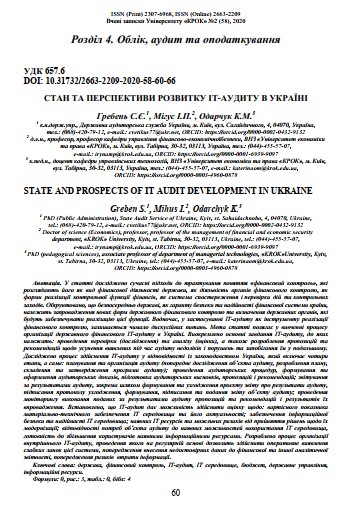STATE AND PROSPECTS OF IT AUDIT DEVELOPMENT IN UKRAINE
DOI:
https://doi.org/10.31732/2663-2209-2020-58-60-66Keywords:
state, financial control, IT audit, IT environment, budget, public administration, information resourcesAbstract
The article examines modern approaches to the interpretation of the concept of "financial control", which consider it as a type of financial activity of the state, as the activity of financial control bodies, as a form of financial control function, as a system of monitoring and verification of actions and controls. It is substantiated that the state, as a guarantor of security and reliability of the country's financial system, is responsible for the introduction of new forms of state financial control and the definition of state bodies that will ensure the implementation of this function. At the same time, in the use of IT audit as a tool for financial control, there are many controversial issues. The purpose of the article is to study the process of organizing public financial IT audit in Ukraine. The main tasks of the IT audit are highlighted, which include: conducting inspections (research) and analysis (evaluation), as well as developing proposals and recommendations for eliminating the shortcomings and violations identified during the audit and preventing them in the future. The process of IT audit in accordance with the legislation of Ukraine, which includes four stages, namely: planning and organization of the audit (preliminary study of the audit object, development of the plan, preparation and approval of the audit program); conducting audit procedures, formation and execution of audit evidence, preparation of audit opinions, proposals and recommendations; reporting on the results of the audit, in particular by forming and approving the draft report on the results of the audit, signing the protocol of approval, formation, signing and submission of the report of the audited entity; monitoring the implementation of the proposals and recommendations submitted as a result of the audit and the results of their implementation.It is established that the IT audit makes it possible to assess: the cost of logistics of the IT environment and its relevance; ensuring information security and reliability of the IT environment; available IT resources and possible risks from decisions on their modernization; compliance of the needs of the audited entity with the available opportunities to use the IT environment, readiness to increase users with available information resources. A process of organizing an internal IT audit has been developed, which will be carried out on a regular basis to quickly identify weaknesses in this system, prevent the introduction of inaccurate data in financial and other analytical reporting, prevent the risk of information loss.
Downloads
References
Гребень С. Є. Удосконалення механізму фінансового контролю за розподілом бюджетних місць в залежності від наукових результатів діяльності закладів вищої освіти. Вчені записки Університету «КРОК». 2018. № 4 (52). С. 103-109.
Гребень С. Є. Фінансовий контроль як інструмент державного управління закладами вищої освіти : дис. … канд. наук з держ. упр. : 25.00.02 / Міжрегіональна академія управління персоналом. Київ, 2019. 243 с. URL : https://drive.google.com/file/d/1L_H9HXLeWqY8ptcwgvOP2eIVZ9MKcUnB/view.
Порядок проведення Державною аудиторською службою, її міжрегіональними територіальними органами державного фінансового аудиту використання інформаційних технологій: постанова Кабінету Міністрів України від 22.05.2019 № 517. URL : http://zakon2.rada.gov.ua/laws/show/1017-2004% D0%BF.
Гребень С. Є. ІТ аудит як нова форма державного фінансового контролю. Achievement of high scool – 2017 : Материали за ХІІІ международна научна практична конференція (15-22.11.2017, София, Република България) Volume 4. София: Бял ГРАД-БГ ОДД, 2017. C. 92-94.


